[English] 日本語
 Yorodumi
Yorodumi- PDB-7w3b: Structure of USP14-bound human 26S proteasome in substrate-engage... -
+ Open data
Open data
- Basic information
Basic information
| Entry | Database: PDB / ID: 7w3b | ||||||
|---|---|---|---|---|---|---|---|
| Title | Structure of USP14-bound human 26S proteasome in substrate-engaged state ED5_USP14 | ||||||
 Components Components |
| ||||||
 Keywords Keywords | HYDROLASE / Proteasome / AAA-ATPase / Deubiquitinase / USP14 | ||||||
| Function / homology |  Function and homology information Function and homology informationnegative regulation of ERAD pathway / thyrotropin-releasing hormone receptor binding / nuclear proteasome complex / host-mediated perturbation of viral transcription / positive regulation of inclusion body assembly / Impaired BRCA2 translocation to the nucleus / Impaired BRCA2 binding to SEM1 (DSS1) / deubiquitinase activity / regulation of chemotaxis / protein K48-linked deubiquitination ...negative regulation of ERAD pathway / thyrotropin-releasing hormone receptor binding / nuclear proteasome complex / host-mediated perturbation of viral transcription / positive regulation of inclusion body assembly / Impaired BRCA2 translocation to the nucleus / Impaired BRCA2 binding to SEM1 (DSS1) / deubiquitinase activity / regulation of chemotaxis / protein K48-linked deubiquitination / Hydrolases; Acting on peptide bonds (peptidases); Omega peptidases / proteasome accessory complex / integrator complex / purine ribonucleoside triphosphate binding / meiosis I / proteasome regulatory particle / cytosolic proteasome complex / positive regulation of proteasomal protein catabolic process / proteasome-activating activity / proteasome regulatory particle, lid subcomplex / proteasome regulatory particle, base subcomplex / hypothalamus gonadotrophin-releasing hormone neuron development / metal-dependent deubiquitinase activity / protein K63-linked deubiquitination / negative regulation of programmed cell death / female meiosis I / Regulation of ornithine decarboxylase (ODC) / positive regulation of protein monoubiquitination / Proteasome assembly / Cross-presentation of soluble exogenous antigens (endosomes) / fat pad development / proteasome core complex / mitochondrion transport along microtubule / Homologous DNA Pairing and Strand Exchange / Defective homologous recombination repair (HRR) due to BRCA1 loss of function / Defective HDR through Homologous Recombination Repair (HRR) due to PALB2 loss of BRCA1 binding function / Defective HDR through Homologous Recombination Repair (HRR) due to PALB2 loss of BRCA2/RAD51/RAD51C binding function / Resolution of D-loop Structures through Synthesis-Dependent Strand Annealing (SDSA) / endopeptidase inhibitor activity / Somitogenesis / Resolution of D-loop Structures through Holliday Junction Intermediates / K63-linked deubiquitinase activity / female gonad development / Impaired BRCA2 binding to RAD51 / seminiferous tubule development / proteasome binding / transcription factor binding / regulation of protein catabolic process / myofibril / male meiosis I / proteasome storage granule / Presynaptic phase of homologous DNA pairing and strand exchange / positive regulation of intrinsic apoptotic signaling pathway by p53 class mediator / general transcription initiation factor binding / blastocyst development / negative regulation of ubiquitin-dependent protein catabolic process / polyubiquitin modification-dependent protein binding / immune system process / protein deubiquitination / NF-kappaB binding / proteasome endopeptidase complex / endopeptidase activator activity / proteasome core complex, beta-subunit complex / mRNA export from nucleus / proteasome assembly / threonine-type endopeptidase activity / proteasome core complex, alpha-subunit complex / energy homeostasis / presynaptic cytosol / regulation of neuron apoptotic process / neuron projection morphogenesis / enzyme regulator activity / regulation of proteasomal protein catabolic process / Maturation of protein E / Maturation of protein E / inclusion body / ER Quality Control Compartment (ERQC) / Myoclonic epilepsy of Lafora / FLT3 signaling by CBL mutants / Prevention of phagosomal-lysosomal fusion / IRAK2 mediated activation of TAK1 complex / Alpha-protein kinase 1 signaling pathway / Glycogen synthesis / IRAK1 recruits IKK complex / IRAK1 recruits IKK complex upon TLR7/8 or 9 stimulation / Endosomal Sorting Complex Required For Transport (ESCRT) / Membrane binding and targetting of GAG proteins / Negative regulation of FLT3 / Regulation of TBK1, IKKε (IKBKE)-mediated activation of IRF3, IRF7 / PTK6 Regulates RTKs and Their Effectors AKT1 and DOK1 / Regulation of TBK1, IKKε-mediated activation of IRF3, IRF7 upon TLR3 ligation / Constitutive Signaling by NOTCH1 HD Domain Mutants / IRAK2 mediated activation of TAK1 complex upon TLR7/8 or 9 stimulation / NOTCH2 Activation and Transmission of Signal to the Nucleus / TICAM1,TRAF6-dependent induction of TAK1 complex / TICAM1-dependent activation of IRF3/IRF7 / APC/C:Cdc20 mediated degradation of Cyclin B / Downregulation of ERBB4 signaling / Regulation of FZD by ubiquitination / APC-Cdc20 mediated degradation of Nek2A Similarity search - Function | ||||||
| Biological species |  Homo sapiens (human) Homo sapiens (human) | ||||||
| Method | ELECTRON MICROSCOPY / single particle reconstruction / cryo EM / Resolution: 3.6 Å | ||||||
 Authors Authors | Zhang, S. / Zou, S. / Yin, D. / Wu, Z. / Mao, Y. | ||||||
| Funding support |  China, 1items China, 1items
| ||||||
 Citation Citation |  Journal: Nature / Year: 2022 Journal: Nature / Year: 2022Title: USP14-regulated allostery of the human proteasome by time-resolved cryo-EM. Authors: Shuwen Zhang / Shitao Zou / Deyao Yin / Lihong Zhao / Daniel Finley / Zhaolong Wu / Youdong Mao /   Abstract: Proteasomal degradation of ubiquitylated proteins is tightly regulated at multiple levels. A primary regulatory checkpoint is the removal of ubiquitin chains from substrates by the deubiquitylating ...Proteasomal degradation of ubiquitylated proteins is tightly regulated at multiple levels. A primary regulatory checkpoint is the removal of ubiquitin chains from substrates by the deubiquitylating enzyme ubiquitin-specific protease 14 (USP14), which reversibly binds the proteasome and confers the ability to edit and reject substrates. How USP14 is activated and regulates proteasome function remain unknown. Here we present high-resolution cryo-electron microscopy structures of human USP14 in complex with the 26S proteasome in 13 distinct conformational states captured during degradation of polyubiquitylated proteins. Time-resolved cryo-electron microscopy analysis of the conformational continuum revealed two parallel pathways of proteasome state transitions induced by USP14, and captured transient conversion of substrate-engaged intermediates into substrate-inhibited intermediates. On the substrate-engaged pathway, ubiquitin-dependent activation of USP14 allosterically reprograms the conformational landscape of the AAA-ATPase motor and stimulates opening of the core particle gate, enabling observation of a near-complete cycle of asymmetric ATP hydrolysis around the ATPase ring during processive substrate unfolding. Dynamic USP14-ATPase interactions decouple the ATPase activity from RPN11-catalysed deubiquitylation and kinetically introduce three regulatory checkpoints on the proteasome, at the steps of ubiquitin recognition, substrate translocation initiation and ubiquitin chain recycling. These findings provide insights into the complete functional cycle of the USP14-regulated proteasome and establish mechanistic foundations for the discovery of USP14-targeted therapies. | ||||||
| History |
|
- Structure visualization
Structure visualization
| Structure viewer | Molecule:  Molmil Molmil Jmol/JSmol Jmol/JSmol |
|---|
- Downloads & links
Downloads & links
- Download
Download
| PDBx/mmCIF format |  7w3b.cif.gz 7w3b.cif.gz | 2.4 MB | Display |  PDBx/mmCIF format PDBx/mmCIF format |
|---|---|---|---|---|
| PDB format |  pdb7w3b.ent.gz pdb7w3b.ent.gz | Display |  PDB format PDB format | |
| PDBx/mmJSON format |  7w3b.json.gz 7w3b.json.gz | Tree view |  PDBx/mmJSON format PDBx/mmJSON format | |
| Others |  Other downloads Other downloads |
-Validation report
| Summary document |  7w3b_validation.pdf.gz 7w3b_validation.pdf.gz | 1.5 MB | Display |  wwPDB validaton report wwPDB validaton report |
|---|---|---|---|---|
| Full document |  7w3b_full_validation.pdf.gz 7w3b_full_validation.pdf.gz | 1.5 MB | Display | |
| Data in XML |  7w3b_validation.xml.gz 7w3b_validation.xml.gz | 285.9 KB | Display | |
| Data in CIF |  7w3b_validation.cif.gz 7w3b_validation.cif.gz | 479.7 KB | Display | |
| Arichive directory |  https://data.pdbj.org/pub/pdb/validation_reports/w3/7w3b https://data.pdbj.org/pub/pdb/validation_reports/w3/7w3b ftp://data.pdbj.org/pub/pdb/validation_reports/w3/7w3b ftp://data.pdbj.org/pub/pdb/validation_reports/w3/7w3b | HTTPS FTP |
-Related structure data
| Related structure data |  32276MC 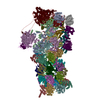 7w37C  7w38C 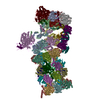 7w39C 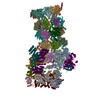 7w3aC 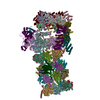 7w3cC 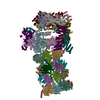 7w3fC 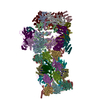 7w3gC 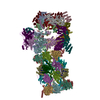 7w3hC 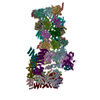 7w3iC 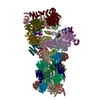 7w3jC 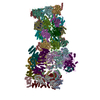 7w3kC 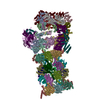 7w3mC M: map data used to model this data C: citing same article ( |
|---|---|
| Similar structure data | Similarity search - Function & homology  F&H Search F&H Search |
- Links
Links
- Assembly
Assembly
| Deposited unit | 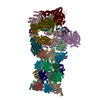
|
|---|---|
| 1 |
|
- Components
Components
-26S protease regulatory subunit ... , 4 types, 4 molecules ABDF
| #1: Protein | Mass: 48700.805 Da / Num. of mol.: 1 Source method: isolated from a genetically manipulated source Source: (gene. exp.)  Homo sapiens (human) / Gene: PSMC2, MSS1 / Production host: Homo sapiens (human) / Gene: PSMC2, MSS1 / Production host:  Homo sapiens (human) / References: UniProt: P35998 Homo sapiens (human) / References: UniProt: P35998 |
|---|---|
| #2: Protein | Mass: 49260.504 Da / Num. of mol.: 1 Source method: isolated from a genetically manipulated source Source: (gene. exp.)  Homo sapiens (human) / Gene: PSMC1 / Production host: Homo sapiens (human) / Gene: PSMC1 / Production host:  Homo sapiens (human) / References: UniProt: P62191 Homo sapiens (human) / References: UniProt: P62191 |
| #4: Protein | Mass: 47426.141 Da / Num. of mol.: 1 Source method: isolated from a genetically manipulated source Source: (gene. exp.)  Homo sapiens (human) / Gene: PSMC4, MIP224, TBP7 / Production host: Homo sapiens (human) / Gene: PSMC4, MIP224, TBP7 / Production host:  Homo sapiens (human) / References: UniProt: P43686 Homo sapiens (human) / References: UniProt: P43686 |
| #6: Protein | Mass: 49266.457 Da / Num. of mol.: 1 Source method: isolated from a genetically manipulated source Source: (gene. exp.)  Homo sapiens (human) / Gene: PSMC3, TBP1 / Production host: Homo sapiens (human) / Gene: PSMC3, TBP1 / Production host:  Homo sapiens (human) / References: UniProt: P17980 Homo sapiens (human) / References: UniProt: P17980 |
-Protein , 4 types, 5 molecules CLlxy
| #3: Protein | Mass: 44852.121 Da / Num. of mol.: 1 Source method: isolated from a genetically manipulated source Source: (gene. exp.)  Homo sapiens (human) / Gene: PSMC5, SUG1 / Production host: Homo sapiens (human) / Gene: PSMC5, SUG1 / Production host:  Homo sapiens (human) / References: UniProt: P62195 Homo sapiens (human) / References: UniProt: P62195 | ||||
|---|---|---|---|---|---|
| #12: Protein | Mass: 30281.473 Da / Num. of mol.: 2 Source method: isolated from a genetically manipulated source Source: (gene. exp.)  Homo sapiens (human) / Gene: PSMA1, HC2, NU, PROS30, PSC2 / Production host: Homo sapiens (human) / Gene: PSMA1, HC2, NU, PROS30, PSC2 / Production host:  Homo sapiens (human) / References: UniProt: P25786 Homo sapiens (human) / References: UniProt: P25786#33: Protein | | Mass: 56133.926 Da / Num. of mol.: 1 Source method: isolated from a genetically manipulated source Source: (gene. exp.)  Homo sapiens (human) / Gene: USP14, TGT / Production host: Homo sapiens (human) / Gene: USP14, TGT / Production host:  #34: Protein | | Mass: 8576.831 Da / Num. of mol.: 1 Source method: isolated from a genetically manipulated source Source: (gene. exp.)  Homo sapiens (human) / Gene: UBB / Production host: Homo sapiens (human) / Gene: UBB / Production host:  |
-26S proteasome ... , 13 types, 13 molecules EUVWXYZabcdfe
| #5: Protein | Mass: 45867.027 Da / Num. of mol.: 1 Source method: isolated from a genetically manipulated source Source: (gene. exp.)  Homo sapiens (human) / Gene: PSMC6 / Production host: Homo sapiens (human) / Gene: PSMC6 / Production host:  Homo sapiens (human) / References: UniProt: A0A087X2I1 Homo sapiens (human) / References: UniProt: A0A087X2I1 |
|---|---|
| #21: Protein | Mass: 105958.234 Da / Num. of mol.: 1 Source method: isolated from a genetically manipulated source Source: (gene. exp.)  Homo sapiens (human) / Gene: PSMD1 / Production host: Homo sapiens (human) / Gene: PSMD1 / Production host:  Homo sapiens (human) / References: UniProt: Q99460 Homo sapiens (human) / References: UniProt: Q99460 |
| #22: Protein | Mass: 61066.500 Da / Num. of mol.: 1 Source method: isolated from a genetically manipulated source Source: (gene. exp.)  Homo sapiens (human) / Gene: PSMD3 / Production host: Homo sapiens (human) / Gene: PSMD3 / Production host:  Homo sapiens (human) / References: UniProt: O43242 Homo sapiens (human) / References: UniProt: O43242 |
| #23: Protein | Mass: 52979.359 Da / Num. of mol.: 1 Source method: isolated from a genetically manipulated source Source: (gene. exp.)  Homo sapiens (human) / Gene: PSMD12 / Production host: Homo sapiens (human) / Gene: PSMD12 / Production host:  Homo sapiens (human) / References: UniProt: O00232 Homo sapiens (human) / References: UniProt: O00232 |
| #24: Protein | Mass: 47526.688 Da / Num. of mol.: 1 Source method: isolated from a genetically manipulated source Source: (gene. exp.)  Homo sapiens (human) / Gene: PSMD11 / Production host: Homo sapiens (human) / Gene: PSMD11 / Production host:  Homo sapiens (human) / References: UniProt: O00231 Homo sapiens (human) / References: UniProt: O00231 |
| #25: Protein | Mass: 45592.285 Da / Num. of mol.: 1 Source method: isolated from a genetically manipulated source Source: (gene. exp.)  Homo sapiens (human) / Gene: PSMD6, KIAA0107, PFAAP4 / Production host: Homo sapiens (human) / Gene: PSMD6, KIAA0107, PFAAP4 / Production host:  Homo sapiens (human) / References: UniProt: Q15008 Homo sapiens (human) / References: UniProt: Q15008 |
| #26: Protein | Mass: 37086.441 Da / Num. of mol.: 1 Source method: isolated from a genetically manipulated source Source: (gene. exp.)  Homo sapiens (human) / Gene: PSMD7, MOV34L / Production host: Homo sapiens (human) / Gene: PSMD7, MOV34L / Production host:  Homo sapiens (human) / References: UniProt: P51665 Homo sapiens (human) / References: UniProt: P51665 |
| #27: Protein | Mass: 42995.359 Da / Num. of mol.: 1 Source method: isolated from a genetically manipulated source Source: (gene. exp.)  Homo sapiens (human) / Gene: PSMD13 / Production host: Homo sapiens (human) / Gene: PSMD13 / Production host:  Homo sapiens (human) / References: UniProt: Q9UNM6 Homo sapiens (human) / References: UniProt: Q9UNM6 |
| #28: Protein | Mass: 40781.590 Da / Num. of mol.: 1 Source method: isolated from a genetically manipulated source Source: (gene. exp.)  Homo sapiens (human) / Gene: PSMD4, MCB1 / Production host: Homo sapiens (human) / Gene: PSMD4, MCB1 / Production host:  Homo sapiens (human) / References: UniProt: P55036 Homo sapiens (human) / References: UniProt: P55036 |
| #29: Protein | Mass: 34620.023 Da / Num. of mol.: 1 Source method: isolated from a genetically manipulated source Source: (gene. exp.)  Homo sapiens (human) / Gene: PSMD14, POH1 / Production host: Homo sapiens (human) / Gene: PSMD14, POH1 / Production host:  Homo sapiens (human) Homo sapiens (human)References: UniProt: O00487, Hydrolases; Acting on peptide bonds (peptidases); Omega peptidases |
| #30: Protein | Mass: 39667.871 Da / Num. of mol.: 1 Source method: isolated from a genetically manipulated source Source: (gene. exp.)  Homo sapiens (human) / Gene: PSMD8 / Production host: Homo sapiens (human) / Gene: PSMD8 / Production host:  Homo sapiens (human) / References: UniProt: P48556 Homo sapiens (human) / References: UniProt: P48556 |
| #31: Protein | Mass: 100313.625 Da / Num. of mol.: 1 Source method: isolated from a genetically manipulated source Source: (gene. exp.)  Homo sapiens (human) / Gene: PSMD2, TRAP2 / Production host: Homo sapiens (human) / Gene: PSMD2, TRAP2 / Production host:  Homo sapiens (human) / References: UniProt: Q13200 Homo sapiens (human) / References: UniProt: Q13200 |
| #35: Protein | Mass: 8284.611 Da / Num. of mol.: 1 Source method: isolated from a genetically manipulated source Source: (gene. exp.)  Homo sapiens (human) / Gene: SHFM1, DSS1, SHFDG1 / Production host: Homo sapiens (human) / Gene: SHFM1, DSS1, SHFDG1 / Production host:  Homo sapiens (human) / References: UniProt: P60896 Homo sapiens (human) / References: UniProt: P60896 |
-Proteasome subunit alpha type- ... , 6 types, 12 molecules GgHhIiJjKkMm
| #7: Protein | Mass: 27432.459 Da / Num. of mol.: 2 Source method: isolated from a genetically manipulated source Source: (gene. exp.)  Homo sapiens (human) / Gene: PSMA6, PROS27 / Production host: Homo sapiens (human) / Gene: PSMA6, PROS27 / Production host:  Homo sapiens (human) Homo sapiens (human)References: UniProt: P60900, proteasome endopeptidase complex #8: Protein | Mass: 25927.535 Da / Num. of mol.: 2 Source method: isolated from a genetically manipulated source Source: (gene. exp.)  Homo sapiens (human) / Gene: PSMA2, HC3, PSC3 / Production host: Homo sapiens (human) / Gene: PSMA2, HC3, PSC3 / Production host:  Homo sapiens (human) Homo sapiens (human)References: UniProt: P25787, proteasome endopeptidase complex #9: Protein | Mass: 29525.842 Da / Num. of mol.: 2 Source method: isolated from a genetically manipulated source Source: (gene. exp.)  Homo sapiens (human) / Gene: PSMA4, HC9, PSC9 / Production host: Homo sapiens (human) / Gene: PSMA4, HC9, PSC9 / Production host:  Homo sapiens (human) Homo sapiens (human)References: UniProt: P25789, proteasome endopeptidase complex #10: Protein | Mass: 27929.891 Da / Num. of mol.: 2 Source method: isolated from a genetically manipulated source Source: (gene. exp.)  Homo sapiens (human) / Gene: PSMA7, HSPC / Production host: Homo sapiens (human) / Gene: PSMA7, HSPC / Production host:  Homo sapiens (human) Homo sapiens (human)References: UniProt: O14818, proteasome endopeptidase complex #11: Protein | Mass: 26435.977 Da / Num. of mol.: 2 Source method: isolated from a genetically manipulated source Source: (gene. exp.)  Homo sapiens (human) / Gene: PSMA5 / Production host: Homo sapiens (human) / Gene: PSMA5 / Production host:  Homo sapiens (human) Homo sapiens (human)References: UniProt: P28066, proteasome endopeptidase complex #13: Protein | Mass: 28469.252 Da / Num. of mol.: 2 Source method: isolated from a genetically manipulated source Source: (gene. exp.)  Homo sapiens (human) / Gene: PSMA3, HC8, PSC8 / Production host: Homo sapiens (human) / Gene: PSMA3, HC8, PSC8 / Production host:  Homo sapiens (human) / References: UniProt: P25788 Homo sapiens (human) / References: UniProt: P25788 |
|---|
-Proteasome subunit beta type- ... , 7 types, 14 molecules NnOoPpQqRrSsTt
| #14: Protein | Mass: 25377.652 Da / Num. of mol.: 2 Source method: isolated from a genetically manipulated source Source: (gene. exp.)  Homo sapiens (human) / Gene: PSMB6, LMPY, Y / Production host: Homo sapiens (human) / Gene: PSMB6, LMPY, Y / Production host:  Homo sapiens (human) Homo sapiens (human)References: UniProt: P28072, proteasome endopeptidase complex #15: Protein | Mass: 30000.418 Da / Num. of mol.: 2 Source method: isolated from a genetically manipulated source Source: (gene. exp.)  Homo sapiens (human) / Gene: PSMB7, Z / Production host: Homo sapiens (human) / Gene: PSMB7, Z / Production host:  Homo sapiens (human) Homo sapiens (human)References: UniProt: Q99436, proteasome endopeptidase complex #16: Protein | Mass: 22972.896 Da / Num. of mol.: 2 Source method: isolated from a genetically manipulated source Source: (gene. exp.)  Homo sapiens (human) / Gene: PSMB3 / Production host: Homo sapiens (human) / Gene: PSMB3 / Production host:  Homo sapiens (human) Homo sapiens (human)References: UniProt: P49720, proteasome endopeptidase complex #17: Protein | Mass: 22864.277 Da / Num. of mol.: 2 Source method: isolated from a genetically manipulated source Source: (gene. exp.)  Homo sapiens (human) / Gene: PSMB2 / Production host: Homo sapiens (human) / Gene: PSMB2 / Production host:  Homo sapiens (human) Homo sapiens (human)References: UniProt: P49721, proteasome endopeptidase complex #18: Protein | Mass: 28510.248 Da / Num. of mol.: 2 Source method: isolated from a genetically manipulated source Source: (gene. exp.)  Homo sapiens (human) / Gene: PSMB5, LMPX, MB1, X / Production host: Homo sapiens (human) / Gene: PSMB5, LMPX, MB1, X / Production host:  Homo sapiens (human) Homo sapiens (human)References: UniProt: P28074, proteasome endopeptidase complex #19: Protein | Mass: 26522.396 Da / Num. of mol.: 2 Source method: isolated from a genetically manipulated source Source: (gene. exp.)  Homo sapiens (human) / Gene: PSMB1, PSC5 / Production host: Homo sapiens (human) / Gene: PSMB1, PSC5 / Production host:  Homo sapiens (human) Homo sapiens (human)References: UniProt: P20618, proteasome endopeptidase complex #20: Protein | Mass: 29231.178 Da / Num. of mol.: 2 Source method: isolated from a genetically manipulated source Source: (gene. exp.)  Homo sapiens (human) / Gene: PSMB4, PROS26 / Production host: Homo sapiens (human) / Gene: PSMB4, PROS26 / Production host:  Homo sapiens (human) Homo sapiens (human)References: UniProt: P28070, proteasome endopeptidase complex |
|---|
-Protein/peptide , 1 types, 1 molecules v
| #32: Protein/peptide | Mass: 2400.951 Da / Num. of mol.: 1 Source method: isolated from a genetically manipulated source Details: The density of substrate does not show clear side-chain, but only main-chain. Source: (gene. exp.)  Production host:  |
|---|
-Non-polymers , 3 types, 5 molecules 




| #36: Chemical | | #37: Chemical | ChemComp-ADP / | #38: Chemical | ChemComp-ZN / | |
|---|
-Details
| Has ligand of interest | Y |
|---|---|
| Has protein modification | Y |
-Experimental details
-Experiment
| Experiment | Method: ELECTRON MICROSCOPY |
|---|---|
| EM experiment | Aggregation state: PARTICLE / 3D reconstruction method: single particle reconstruction |
- Sample preparation
Sample preparation
| Component |
| ||||||||||||||||||||||||||||||
|---|---|---|---|---|---|---|---|---|---|---|---|---|---|---|---|---|---|---|---|---|---|---|---|---|---|---|---|---|---|---|---|
| Molecular weight | Value: 1.6 MDa / Experimental value: YES | ||||||||||||||||||||||||||||||
| Source (natural) |
| ||||||||||||||||||||||||||||||
| Source (recombinant) |
| ||||||||||||||||||||||||||||||
| Buffer solution | pH: 7 | ||||||||||||||||||||||||||||||
| Specimen | Embedding applied: NO / Shadowing applied: NO / Staining applied: NO / Vitrification applied: YES | ||||||||||||||||||||||||||||||
| Vitrification | Cryogen name: ETHANE |
- Electron microscopy imaging
Electron microscopy imaging
| Experimental equipment |  Model: Titan Krios / Image courtesy: FEI Company |
|---|---|
| Microscopy | Model: FEI TITAN KRIOS |
| Electron gun | Electron source:  FIELD EMISSION GUN / Accelerating voltage: 300 kV / Illumination mode: FLOOD BEAM FIELD EMISSION GUN / Accelerating voltage: 300 kV / Illumination mode: FLOOD BEAM |
| Electron lens | Mode: BRIGHT FIELD / Nominal defocus max: 5000 nm / Nominal defocus min: 400 nm |
| Image recording | Electron dose: 50 e/Å2 / Film or detector model: GATAN K2 SUMMIT (4k x 4k) |
- Processing
Processing
| CTF correction | Type: PHASE FLIPPING AND AMPLITUDE CORRECTION |
|---|---|
| 3D reconstruction | Resolution: 3.6 Å / Resolution method: FSC 0.143 CUT-OFF / Num. of particles: 35156 / Symmetry type: POINT |
 Movie
Movie Controller
Controller






















 PDBj
PDBj


























